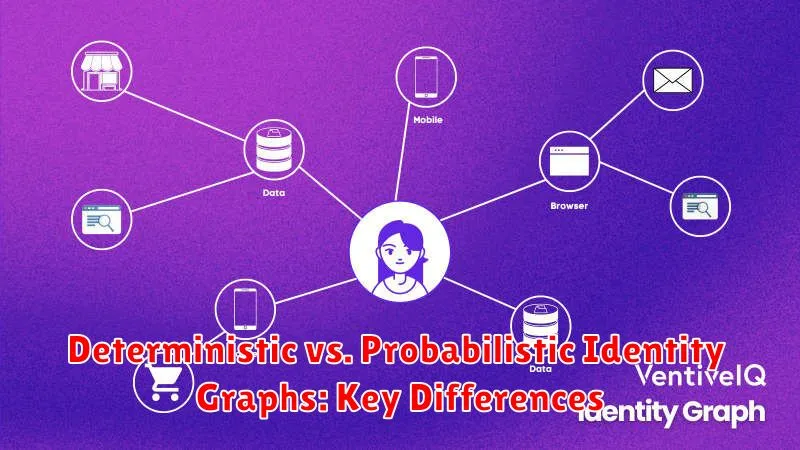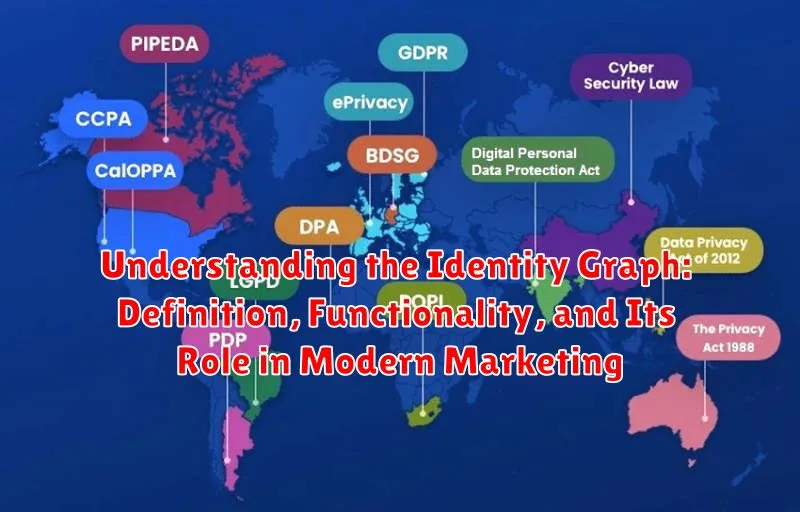In today’s intricate digital landscape, understanding the identity graph is paramount for successful marketing endeavors. This introductory exploration will delve into the core definition of an identity graph, dissect its fundamental functionality, and illuminate its critical role in the ever-evolving sphere of modern marketing. We will navigate the complexities of connecting fragmented customer data points to forge a unified view of the individual, a capability that directly impacts campaign effectiveness and overall marketing ROI. As businesses grapple with an explosion of data sources and channels, mastering the concept of the identity graph emerges as a key differentiator in gaining a competitive edge.
This article aims to provide a comprehensive overview for an international audience seeking to grasp the power of identity resolution. We will explore how identity graphs aggregate data from various online and offline sources—including website interactions, mobile app usage, CRM systems, and social media platforms—to create a single, persistent identifier for each customer. By understanding the mechanics of the identity graph, marketers can unlock the ability to personalize experiences, optimize ad spend, and measure campaign performance with unprecedented accuracy. The insights gleaned from a well-constructed identity graph are not merely advantageous; they are becoming increasingly essential for navigating the complexities of modern marketing and achieving sustainable growth.
What is an Identity Graph?
An Identity Graph is a data structure that maps customer identities across various touchpoints and platforms. It acts as a unified representation of an individual, connecting disparate data points—such as email addresses, mobile device IDs, social media profiles, and website interactions—to form a comprehensive view of that person.
Essentially, it’s a centralized hub that resolves fragmented data into a single, persistent customer profile. This enables marketers and organizations to recognize and understand their customers more holistically, regardless of the channel they’re engaging on.
The core purpose of an Identity Graph is to provide a single customer view by resolving identities across different identifiers, leading to more personalized and effective marketing strategies. By linking these identifiers, businesses can gain insights into customer behavior, preferences, and interactions across all touchpoints.
The Core Components of an Identity Graph
An identity graph is built upon several essential components that enable its functionality. These components work in concert to create a unified view of customer identity.
1. Data Sources: These are the diverse sources from which customer data is collected. Common sources include:
- CRM Systems: Containing customer relationship data.
- Marketing Automation Platforms: Tracking engagement with marketing campaigns.
- Web Analytics: Monitoring website activity.
- Mobile Apps: Capturing user behavior within mobile applications.
- Social Media Platforms: Providing social profile information.
2. Identifiers: These are the specific data points used to identify and link customer profiles. Examples include:
- Email Addresses: A primary identifier.
- Phone Numbers: Used for communication and identification.
- Device IDs: Unique identifiers for devices.
- Customer IDs: Internal identifiers assigned by businesses.
3. Matching Algorithms: These algorithms determine how identifiers are linked together to form a unified profile. They can be deterministic or probabilistic.
4. Graph Database: This database stores the relationships between identifiers and profiles, allowing for efficient querying and analysis.
Deterministic vs. Probabilistic Identity Graphs: Key Differences

Deterministic identity graphs rely on directly identifiable information (PII) like email addresses, phone numbers, and physical addresses to link customer profiles. These connections are considered highly accurate due to the definitive nature of the data.
In contrast, probabilistic identity graphs use algorithms and machine learning to infer identity connections based on behavioral data, contextual clues, and device information. This approach estimates the likelihood of different profiles belonging to the same individual.
Key Distinctions Summarized:
- Data Source: Deterministic uses direct PII; Probabilistic uses inferred data.
- Accuracy: Deterministic offers higher accuracy; Probabilistic involves inherent uncertainty.
- Scale: Probabilistic can reach a wider audience due to relying on less sensitive data; Deterministic is limited to PII availability.
- Maintenance: Probabilistic requires continuous refinement of algorithms; Deterministic needs robust data hygiene practices.
How Identity Graphs Enhance Customer Experience
Identity graphs play a crucial role in enhancing customer experience by providing a unified view of each customer across various touchpoints. This single customer view allows businesses to deliver personalized experiences, targeted messaging, and relevant content.
By connecting fragmented customer data from different sources, identity graphs enable marketers to understand customer preferences, behaviors, and needs more comprehensively. This deeper understanding facilitates:
- Personalized Recommendations: Providing relevant product or service suggestions based on past interactions.
- Consistent Messaging: Ensuring a seamless brand experience across all channels.
- Improved Customer Service: Empowering customer service representatives with a complete customer history for faster and more effective support.
- Reduced Friction: Streamlining the customer journey by pre-filling forms and offering personalized offers.
Ultimately, the improved understanding and personalization driven by identity graphs lead to increased customer satisfaction and loyalty.
Identity Resolution: Linking Identities Across Channels
Identity resolution is the process of accurately connecting disparate data points to create a unified view of an individual across various channels and devices. This is crucial for building a comprehensive customer profile within an identity graph.
Achieving effective identity resolution involves several key steps:
- Data Collection: Gathering customer information from multiple touchpoints (e.g., website visits, app usage, email interactions, in-store purchases).
- Data Standardization: Cleaning and standardizing data to ensure consistency and accuracy.
- Matching Techniques: Employing deterministic and probabilistic methods to link identities based on shared attributes.
- Validation and Refinement: Continuously monitoring and refining the matching process to improve accuracy and reduce errors.
By successfully resolving identities, businesses can gain a more holistic understanding of their customers, leading to improved personalization, targeted marketing, and enhanced customer experiences.
Benefits of Using an Identity Graph for Marketing
The implementation of an identity graph provides several distinct benefits for marketing initiatives. By consolidating fragmented customer data into a unified view, marketers can achieve enhanced targeting capabilities and personalization strategies.
Here are some key advantages:
- Improved Targeting: Identify and reach the right audience with precision, reducing wasted ad spend.
- Enhanced Personalization: Deliver relevant and tailored experiences to customers across all touchpoints.
- Optimized Customer Journeys: Understand customer behavior and create seamless, personalized journeys that drive conversions.
- Increased ROI: Maximize the return on investment for marketing campaigns by improving efficiency and effectiveness.
- Better Attribution: Accurately attribute marketing efforts to specific customer actions and conversions, leading to data-driven decision-making.
Ultimately, an identity graph allows marketers to move beyond guesswork and make informed decisions based on a complete and accurate understanding of their customer base.
Challenges and Considerations When Implementing Identity Graphs
Implementing identity graphs, while offering significant advantages, presents several challenges and considerations. These primarily revolve around data quality, privacy compliance, and technological infrastructure.
Data Quality and Accuracy
Maintaining high data quality is crucial. Inaccurate or incomplete data can lead to flawed identity resolution and ineffective marketing efforts. Data cleansing and validation processes are essential.
Privacy and Compliance
Adhering to data privacy regulations (e.g., GDPR, CCPA) is paramount. Ensuring transparency and obtaining proper consent for data collection and usage are critical for ethical and legal compliance.
Technological Infrastructure and Integration
Integrating an identity graph with existing marketing technology stacks can be complex. Compatibility issues and the need for specialized expertise may pose significant hurdles.
Cost and Resources
The initial investment in identity graph technology, along with ongoing maintenance and operational costs, can be substantial. Organizations must carefully assess their budget and resource allocation.
The Future of Identity Graphs: Trends and Predictions

The trajectory of identity graphs points towards increased sophistication and integration. Several key trends are shaping their future.
Enhanced Accuracy and Scalability
Expect advancements in machine learning and artificial intelligence to improve the accuracy and scalability of identity resolution. This includes better handling of complex and fragmented data.
Privacy-Preserving Technologies
Emphasis on privacy-enhancing technologies (PETs) like differential privacy and federated learning will become more pronounced to address growing privacy concerns and regulations.
Real-Time Identity Resolution
The demand for real-time identity resolution will increase, enabling immediate personalization and decision-making across all customer touchpoints.
Integration with Emerging Technologies
Identity graphs will likely integrate with emerging technologies such as blockchain for secure identity verification and the metaverse for managing digital identities in virtual environments.
Focus on Interoperability
Greater emphasis on interoperability between different identity graph solutions to facilitate seamless data exchange and collaboration.
Identity Graph Use Cases Across Industries
Identity graphs are finding diverse applications across various industries, revolutionizing how businesses understand and engage with their customers. Their ability to unify disparate data points into a single customer view enables more effective and personalized strategies.
Retail
In retail, identity graphs facilitate personalized product recommendations, targeted advertising campaigns, and improved customer loyalty programs by understanding purchasing habits across online and offline channels.
Financial Services
Financial institutions leverage identity graphs for fraud detection by identifying suspicious patterns and linking fraudulent activities to specific individuals. They also use them to personalize banking services and improve customer onboarding processes.
Healthcare
Healthcare providers utilize identity graphs to create a comprehensive patient view, enabling personalized treatment plans, improved patient communication, and streamlined administrative processes. This ensures patient data is accurately matched, leading to better care coordination.
Media and Entertainment
Media companies employ identity graphs to deliver personalized content recommendations, target advertising based on viewing habits, and optimize subscription services by understanding audience preferences across multiple platforms.
Best Practices for Maintaining Data Privacy within Identity Graphs
Maintaining data privacy within identity graphs is paramount. These graphs often contain sensitive customer information, making them attractive targets for data breaches and raising concerns about regulatory compliance.
Data Minimization
Collect only the data that is absolutely necessary for the intended purpose. Avoid accumulating extraneous data points that increase risk.
Anonymization and Pseudonymization
Employ techniques like hashing and tokenization to de-identify data. Use pseudonyms instead of direct identifiers whenever possible.
Consent Management
Obtain explicit consent from users for data collection and usage. Implement a transparent and easy-to-understand consent mechanism.
Data Governance Policies
Establish clear data governance policies that define roles, responsibilities, and procedures for data handling, access, and security. Regularly audit these policies.
Security Measures
Implement robust security measures, including encryption, access controls, and intrusion detection systems, to protect the identity graph from unauthorized access and cyber threats. Regularly update security protocols.
Compliance with Regulations
Ensure compliance with relevant data privacy regulations such as GDPR, CCPA, and other applicable laws. Stay informed about changes in regulations and adapt your practices accordingly.

